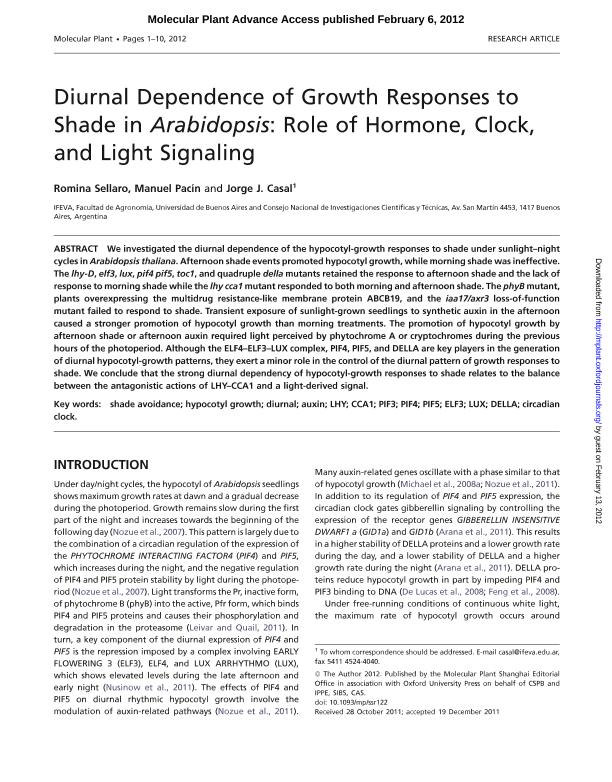Artículo
Diurnal dependence of growth responses to shade in Arabidopsis: role of hormone, clock, and light signaling
Fecha de publicación:
05/2012
Editorial:
Elsevier
Revista:
Molecular Plant
ISSN:
1752-9867
Idioma:
Inglés
Tipo de recurso:
Artículo publicado
Clasificación temática:
Resumen
We investigated the diurnal dependence of the hypocotyl-growth responses to shade under sunlight–night cycles in Arabidopsis thaliana. Afternoon shade events promoted hypocotyl growth, while morning shade was ineffective. The lhy-D, elf3, lux, pif4 pif5, toc1, and quadruple della mutants retained the response to afternoon shade and the lack of response to morning shade while the lhy cca1 mutant responded to both morning and afternoon shade. The phyB mutant, plants overexpressing the multidrug resistance-like membrane protein ABCB19, and the iaa17/axr3 loss-of-function mutant failed to respond to shade. Transient exposure of sunlight-grown seedlings to synthetic auxin in the afternoon caused a stronger promotion of hypocotyl growth than morning treatments. The promotion of hypocotyl growth by afternoon shade or afternoon auxin required light perceived by phytochrome A or cryptochromes during the previous hours of the photoperiod. Although the ELF4–ELF3–LUX complex, PIF4, PIF5, and DELLA are key players in the generation of diurnal hypocotyl-growth patterns, they exert a minor role in the control of the diurnal pattern of growth responses to shade. We conclude that the strong diurnal dependency of hypocotyl-growth responses to shade relates to the balance between the antagonistic actions of LHY–CCA1 and a light-derived signal.
Palabras clave:
Shade
,
Lhy Cca1
,
Diurnal Dependence
,
Hormone
Archivos asociados
Licencia
Identificadores
Colecciones
Articulos(IFEVA)
Articulos de INST.D/INV.FISIOLOGICAS Y ECO.VINCULADAS A L/AGRIC
Articulos de INST.D/INV.FISIOLOGICAS Y ECO.VINCULADAS A L/AGRIC
Citación
Sellaro, Romina Vanesa; Pacín, Manuel; Casal, Jorge Jose; Diurnal dependence of growth responses to shade in Arabidopsis: role of hormone, clock, and light signaling; Elsevier; Molecular Plant; 5; 3; 5-2012; 619-628
Compartir
Altmétricas




